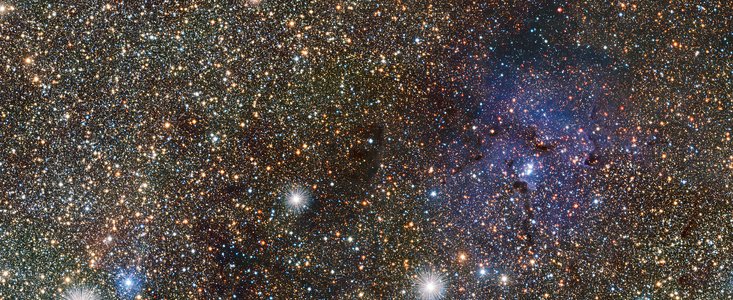Press Release
VISTA Stares Right Through the Milky Way
New infrared view of the Trifid Nebula reveals new variable stars far beyond
4 February 2015
A new image taken with ESO’s VISTA survey telescope reveals the famous Trifid Nebula in a new and ghostly light. By observing in infrared light, astronomers can see right through the dust-filled central parts of the Milky Way and spot many previously hidden objects. In just this tiny part of one of the VISTA surveys, astronomers have discovered two unknown and very distant Cepheid variable stars that lie almost directly behind the Trifid. They are the first such stars found that lie in the central plane of the Milky Way beyond its central bulge.
As one of its major surveys of the southern sky, the VISTA telescope at ESO’s Paranal Observatory in Chile is mapping the central regions of the Milky Way in infrared light to search for new and hidden objects. This VVV survey (standing for VISTA Variables in the Via Lactea) is also returning to the same parts of the sky again and again to spot objects that vary in brightness as time passes.
A tiny fraction of this huge VVV dataset has been used to create this striking new picture of a famous object, the star formation region Messier 20, usually called the Trifid Nebula, because of the ghostly dark lanes that divide it into three parts when seen through a telescope.
The familiar pictures of the Trifid show it in visible light, where it glows brightly in both the pink emission from ionised hydrogen and the blue haze of scattered light from hot young stars. Huge clouds of light-absorbing dust are also prominent. But the view in the VISTA infrared picture is very different. The nebula is just a ghost of its usual visible-light self. The dust clouds are far less prominent and the bright glow from the hydrogen clouds is barely visible at all. The three-part structure is almost invisible.
In the new image, as if to compensate for the fading of the nebula, a spectacular new panorama comes into view. The thick dust clouds in the disc of our galaxy that absorb visible light allow through most of the infrared light that VISTA can see. Rather than the view being blocked, VISTA can see far beyond the Trifid and detect objects on the other side of the galaxy that have never been seen before.
By chance this picture shows a perfect example of the surprises that can be revealed when imaging in the infrared. Apparently close to the Trifid in the sky, but in reality about seven times more distant [1], a newly discovered pair of variable stars has been found in the VISTA data. These are Cepheid variables, a type of bright star that is unstable and slowly brightens and then fades with time. This pair of stars, which the astronomers think are the brightest members of a cluster of stars, are the only Cepheid variables detected so far that are close to the central plane, but on the far side of the galaxy. They brighten and fade over a period of eleven days.
Notes
[1] The Trifid Nebula lies about 5200 light-years from Earth, the centre of the Milky Way is about 27 000 light-years away, in almost the same direction, and the newly discovered Cepheids are at a distance of about 37 000 light-years.
More information
These results were presented in a paper entitled “Discovery of a Pair of Classical Cepheids in an Invisible Cluster Beyond the Galactic Bulge”, by I. Dekany et al., recently published in Astrophysical Journal Letters.
The team is composed of I. Dékány (Millennium Institute of Astrophysics, Santiago, Chile; Universidad Católica de Chile, Santiago, Chile), D. Minniti (Universidad Andres Bello, Santiago, Chile; Millennium Institute of Astrophysics; Center for Astrophysics and Associated Technologies; Vatican Observatory, Vatican City State, Italy), G. Hajdu (Universidad Católica de Chile; Millennium Institute of Astrophysics), J. Alonso-García (Universidad Católica de Chile; Millennium Institute of Astrophysics), M. Hempel (Universidad Católica de Chile), T. Palma (Millennium Institute of Astrophysics; Universidad Católica de Chile;), M. Catelan (Universidad Católica de Chile; Millennium Institute of Astrophysics), W. Gieren (Millennium Institute of Astrophysics; Universidad de Concepción, Chile) and D. Majaes (Saint Mary's University, Halifax, Canada; Mount Saint Vincent University, Halifax, Canada).
ESO is the foremost intergovernmental astronomy organisation in Europe and the world’s most productive ground-based astronomical observatory by far. It is supported by 16 countries: Austria, Belgium, Brazil, Czechia, Denmark, France, Finland, Germany, Italy, the Netherlands, Poland, Portugal, Spain, Sweden, Switzerland and the United Kingdom, along with the host state of Chile. ESO carries out an ambitious programme focused on the design, construction and operation of powerful ground-based observing facilities enabling astronomers to make important scientific discoveries. ESO also plays a leading role in promoting and organising cooperation in astronomical research. ESO operates three unique world-class observing sites in Chile: La Silla, Paranal and Chajnantor. At Paranal, ESO operates the Very Large Telescope, the world’s most advanced visible-light astronomical observatory and two survey telescopes. VISTA works in the infrared and is the world’s largest survey telescope and the VLT Survey Telescope is the largest telescope designed to exclusively survey the skies in visible light. ESO is a major partner in ALMA, the largest astronomical project in existence. And on Cerro Armazones, close to Paranal, ESO is building the 39-metre European Extremely Large Telescope, the E-ELT, which will become “the world’s biggest eye on the sky”.
Links
Contacts
Richard Hook
ESO education and Public Outreach Department
Garching bei München, Germany
Tel: +49 89 3200 6655
Cell: +49 151 1537 3591
Email: rhook@eso.org
About the Release
| Release No.: | eso1504 |
| Name: | M 20, Messier 20, Trifid Nebula |
| Type: | Solar System : Nebula |
| Facility: | Visible and Infrared Survey Telescope for Astronomy |
| Instruments: | VIRCAM |
| Science data: | 2015ApJ...799L..11D |









